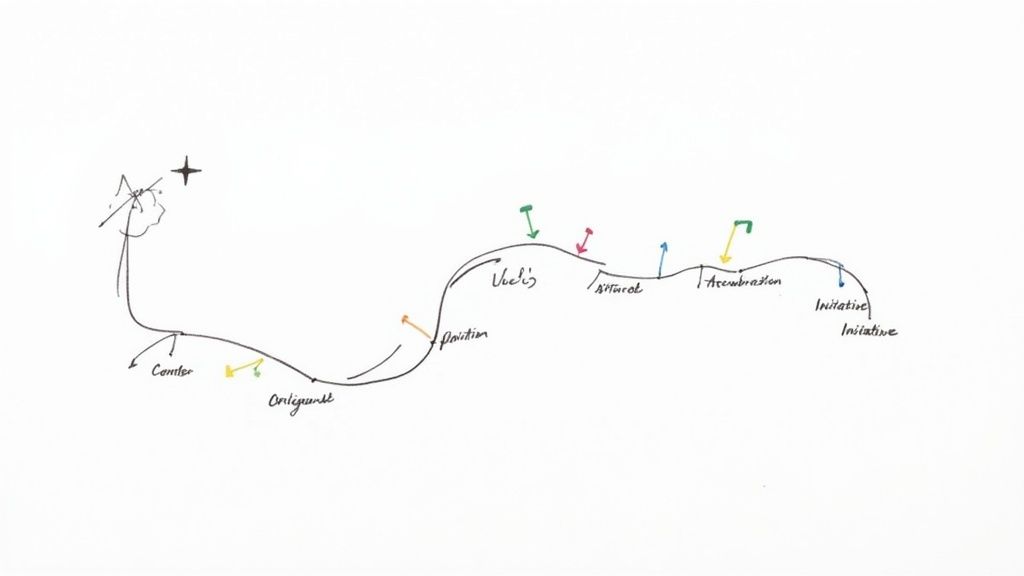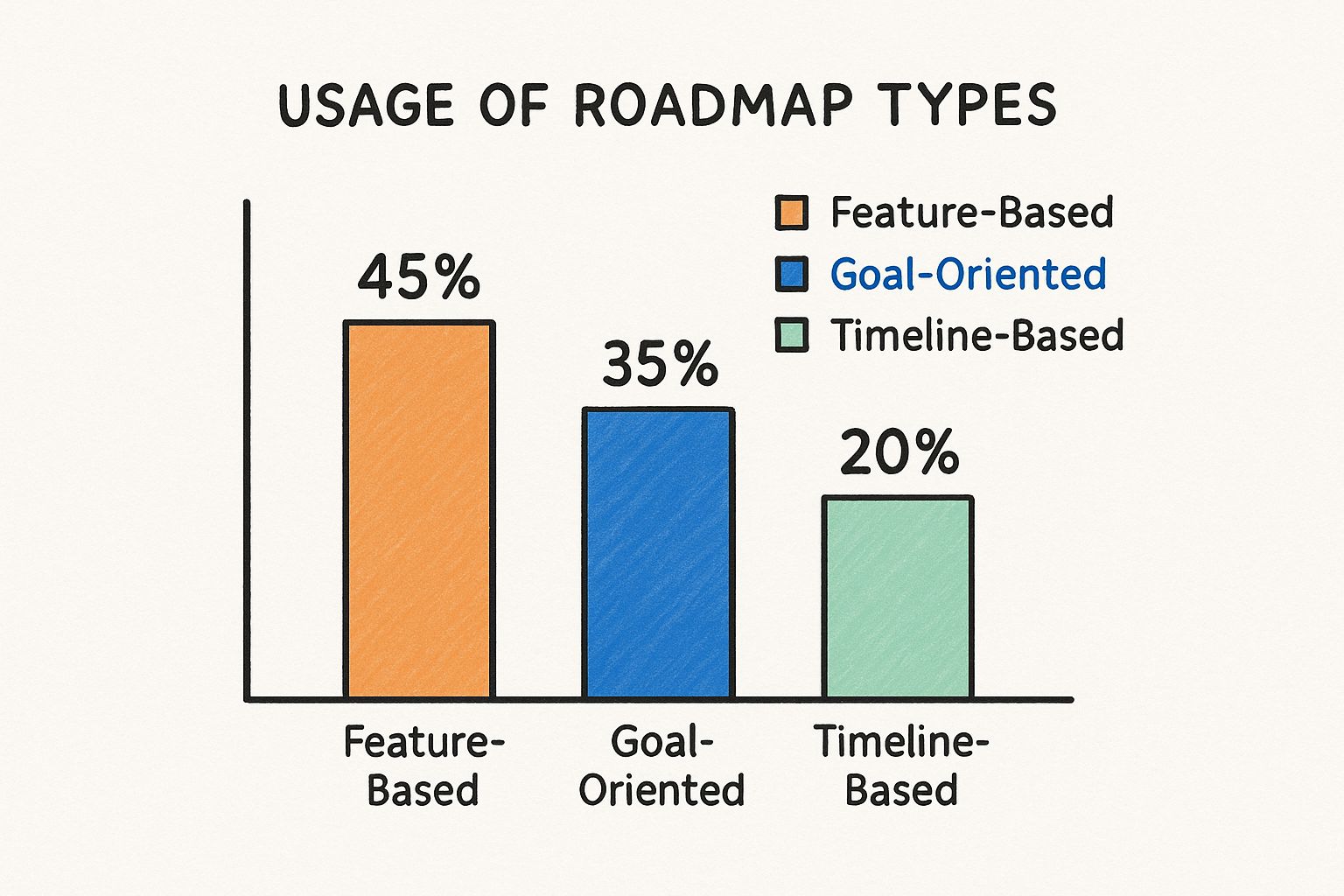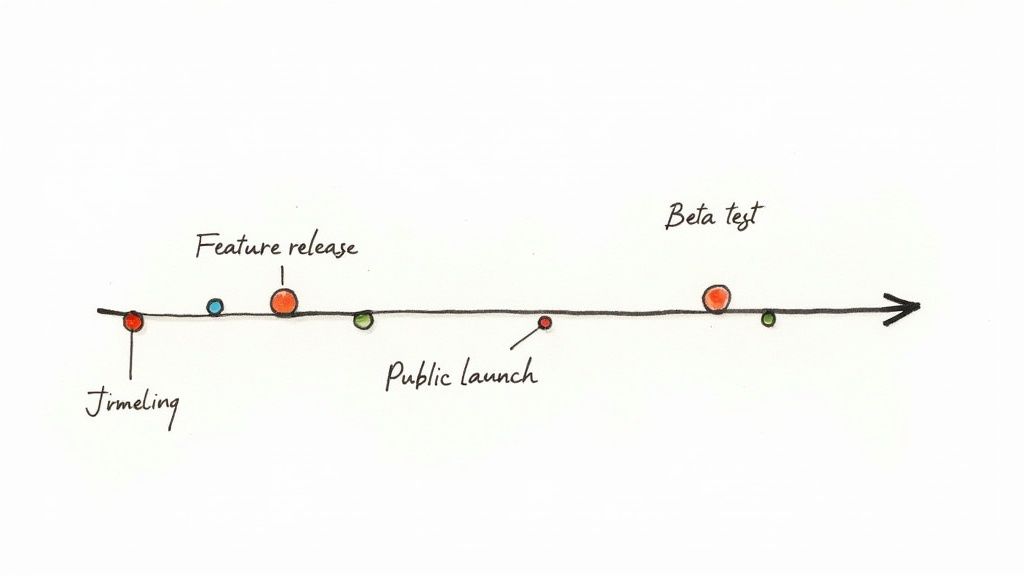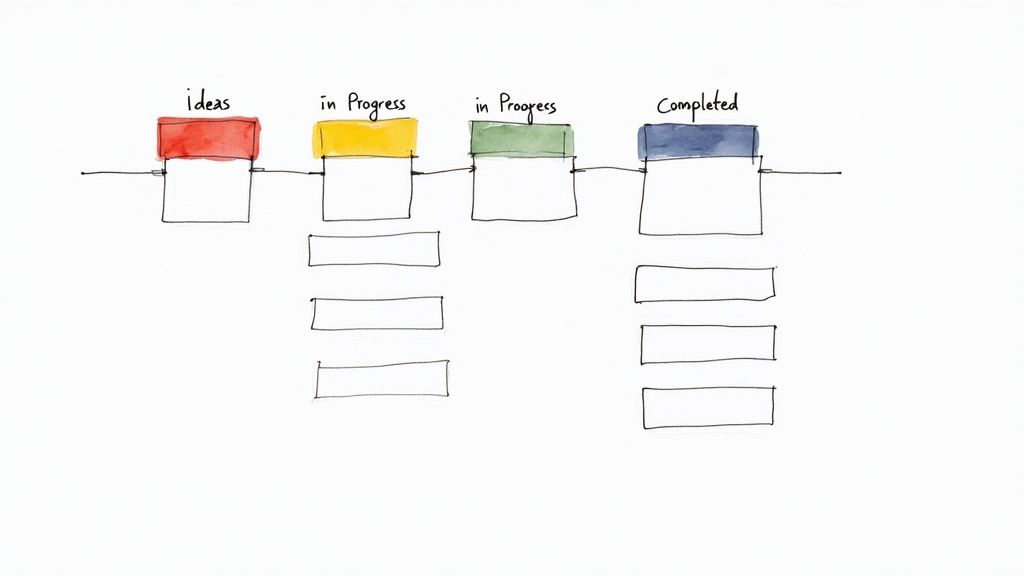Ultimate Guide to Creating a Product Roadmap That Drives Success

Maxime Dupré
10/3/2025

Think of a product roadmap as the strategic story of your product. It’s a high-level, visual guide that shows where you’re going and, more importantly, why you're heading in that direction. It's not a rigid project plan listing every single task; instead, it's the connective tissue between your big-picture vision and the day-to-day work your teams are doing.
What Is a Product Roadmap Really For?

Imagine trying to build a complex Lego set, but instead of the picture on the box, you only have a giant pile of bricks. You'd have all the necessary parts, but absolutely no context for how they fit together. A product roadmap is that picture on the box—it provides the strategic context for every feature, update, and bug fix.
Its core job is to get everyone on the same page. Without it, you'll find your engineering, marketing, sales, and leadership teams drifting into their own little worlds. They might be working on good things, but if those things don't align with the bigger company goals, you're just spinning your wheels.
Creating Strategic Alignment
A solid product roadmap becomes the single source of truth for the entire organization. It deliberately avoids getting stuck in the weeds of daily tasks or individual sprints. Instead, it focuses on broad themes and the outcomes you want to achieve, answering the big questions for everyone involved:
- For Developers: "How does this feature I'm building fit into the bigger picture?"
- For Sales: "What exciting new capabilities can I start talking about with customers for the next few quarters?"
- For Leadership: "Is our investment in this product actually moving our business forward?"
- For Marketing: "What are the major product stories we need to start crafting?"
This alignment is everything. When teams truly understand the "why" behind their work, they're empowered to make smarter decisions on their own, all pushing the product in the right direction. For a deeper dive, check out a foundational guide to product roadmaps which breaks this down further.
A great product roadmap is a statement of intent. It’s a communication tool that makes sure everyone isn't just busy, but busy working on the right things—the things that actually matter to customers and the business.
A Communication Tool First
At its heart, a roadmap is less of a project plan and more of a persuasive document. It's designed to spark conversations and get buy-in from key stakeholders. It makes priorities clear, visualizes the trade-offs you're making, and helps manage expectations across the entire company. By focusing on outcomes (solving a customer problem) over outputs (shipping a feature), it completely changes the conversation.
This shift toward strategic alignment is happening everywhere. The global market for product roadmap and management tools is exploding and is projected to reach $2.5 billion by 2025. This shows just how seriously companies are taking cross-functional collaboration and strategic planning. A key part of building a strong strategy is understanding the competitive landscape. If you're curious, you can learn more about what is competitive intelligence and see how it fits into the roadmap process.
Choosing the Right Roadmap Format
A product roadmap isn't a one-size-fits-all document. Think of it like a map: you wouldn't use a simple city map for a cross-country road trip, right? The right roadmap format depends entirely on who you're talking to and what you need to accomplish.
Picking the wrong one is a recipe for confusion and missed expectations. A high-level, strategic view for your executive team needs to look completely different from the nitty-gritty details your engineering team relies on. Each format tells a unique story.
This infographic gives a great breakdown of how product teams are actually using different roadmap types today.

As you can see, while feature-based roadmaps are still common, there's a clear trend toward goal-oriented and timeline-based views that better connect work to real business outcomes.
Feature-Driven Roadmaps
This is the classic, most traditional format. A feature-driven roadmap organizes everything around a timeline of specific features and enhancements. It’s usually structured by quarters or release versions, making it crystal clear what is being built and when.
This approach is fantastic for internal development teams. It gives them the tactical clarity they need to plan sprints and manage resources, answering the question, "What are we building next?" with total precision.
But it has a big downside: it's rigid. By locking in specific features and dates, you create a false sense of certainty. This makes it tough to pivot when you get new customer feedback or the market shifts. It also risks creating a culture focused on just "shipping features" (outputs) instead of actually solving customer problems (outcomes).
Outcome-Based Roadmaps
Instead of focusing on features, an outcome-based roadmap shifts the conversation to goals. Rather than listing what you'll build, it outlines the customer or business problems you plan to solve. Think objectives like, "Increase user retention by 15%" or "Reduce onboarding friction for new customers."
This is a game-changer. It gives your teams the autonomy to figure out the best way to hit those goals. It’s also the perfect way to communicate with leadership because it directly ties product development work to measurable business value.
An outcome-based product roadmap encourages strategic thinking. It ensures every initiative is justified by the impact it's expected to have, moving the conversation from "When will it be done?" to "What problem are we solving?"
The main challenge? It can feel a bit too abstract for teams that need concrete tasks. It works best in a mature product culture where teams are comfortable with ambiguity and trusted to innovate.
Now-Next-Later Roadmaps
The Now Next Later Roadmap is a brilliant compromise, striking a powerful balance between strategic flexibility and tactical clarity. It has become incredibly popular for a reason.
It elegantly breaks work down into three simple time horizons:
- Now: What the team is actively working on. These are well-defined, committed initiatives.
- Next: What’s on deck for the near future. These items are fairly well-scoped but not yet in development.
- Later: Big ideas and potential opportunities for the long term. These are much less defined and subject to change as you learn more.
This structure is a genius way to communicate priorities without the pressure of hard deadlines. It reflects a major industry shift away from static feature lists toward more dynamic, adaptable planning.
Comparing Product Roadmap Types
Choosing the right format can feel overwhelming, but it really just comes down to matching the roadmap's style to its purpose and its audience. This table breaks down the key differences to help you decide which one fits your situation best.
| Roadmap Type | Primary Focus | Best For (Audience) | Key Benefit |
|---|---|---|---|
| Feature-Driven | What gets built and when | Internal Development & Engineering Teams | Provides tactical clarity and a clear delivery schedule. |
| Outcome-Based | Why work is being done (the goal) | Executives, Stakeholders, & Leadership | Aligns product work directly with business value and strategic goals. |
| Now-Next-Later | Prioritization and flexibility | All audiences (internal and external) | Communicates priorities clearly without committing to rigid, long-term dates. |
Ultimately, many teams find that a hybrid approach works best, using different formats for different conversations. The key is to be intentional about what you're trying to communicate and to whom.
Anatomy of an Effective Product roadmap

A truly effective product roadmap is so much more than a feature list with dates slapped on it. It’s a strategic document, carefully crafted to tell your product's story. Each part plays a crucial role. Think of it like a car—you need the engine, the wheels, and the steering system all working together to get anywhere. A roadmap needs its own core components to drive your strategy forward.
When you get these elements right, you create a clear, compelling picture of where you’re headed and why it matters. If you leave them out, the roadmap quickly becomes a confusing, tactical to-do list that fails to align anyone.
Let's pull back the curtain and look at the essential anatomy of a roadmap that actually works.
The Foundation: Your Product Vision
Everything—and I mean everything—starts here. The product vision is your North Star. It's a concise, aspirational statement that captures the ultimate purpose of your product. It answers the big, hairy question: "What future are we trying to create for our customers?"
This isn’t some quarterly goal; it’s the long-term destination that guides every single decision along the way. A great vision statement is inspiring and acts as a stable anchor for the entire roadmap.
For instance, a vision for an internal communication tool might be: "To create a more connected and informed workforce, where every employee feels heard and valued." Every single thing on that roadmap should have a clear line connecting back to this guiding principle.
Organizing Work with Strategic Themes
Once you have that vision, you need to break it down into manageable chunks. That's where strategic themes come in. These are high-level goals that group related initiatives, shifting the conversation away from a random list of features and toward the actual problems you're trying to solve.
So, instead of a theme like "Build New Dashboard," you’d aim for something more strategic, like "Improve User Onboarding and Activation." See the difference? The first is a task; the second is an outcome.
These themes become the main chapters in your product's story for the next year or so. They often cover broad areas like:
- Market Expansion: Focusing on initiatives to break into new regions or customer segments.
- Performance and Scalability: Grouping the technical work needed to support future growth.
- User Retention: Concentrating on efforts to reduce churn and make customers stick around.
A product roadmap without clear themes is just a to-do list. Themes provide the strategic narrative, connecting the day-to-day work of your teams to the bigger business objectives that leadership cares about.
Bringing Themes to Life with Initiatives
If themes are the "what we want to achieve," then initiatives are the "how we’re going to do it." An initiative is a large, complex project—or a collection of features—that brings a strategic theme to life. These are the big rocks you need to move to make meaningful progress.
Let's go back to our theme, "Improve User Onboarding and Activation." The initiatives to support it might include:
- Redesign the Welcome Experience: A project focused on creating a more guided and personalized first-time user journey.
- Implement In-App Tutorials: Building interactive guides to help users discover key features on their own.
- Launch a Customer Onboarding Webinar Series: A marketing and success initiative to support new users.
Each initiative is a significant undertaking, likely spanning multiple development sprints or even an entire quarter.
Handling Timelines with Flexibility
One of the biggest traps product teams fall into is committing to rigid, long-term deadlines. A smart roadmap dodges this bullet by using broad time horizons instead of specific dates. The classic "Now-Next-Later" format is perfect for this, as it clearly communicates priority without creating a false sense of certainty.
This approach keeps your roadmap flexible. It allows you to react to fresh customer feedback or a shift in the market without constantly "missing" deadlines that were just guesses to begin with.
Measuring Success with KPIs and OKRs
So, how do you know if any of this is actually working? You have to measure what matters. This is why weaving Key Performance Indicators (KPIs) or Objectives and Key Results (OKRs) directly into your roadmap is absolutely essential.
This final component ties every initiative back to a measurable business outcome. It’s the proof that your product efforts aren't just about shipping features; they're about driving real, quantifiable results.
For an initiative like "Redesign the Welcome Experience," a key result might be "Increase new user activation rate from 40% to 60% by the end of Q3." This creates accountability and ensures everyone is crystal clear on what success looks like. Without these metrics, you’re just flying blind.
Building Your First Product Roadmap

Putting together your first product roadmap can seem daunting. You’ve got the destination in mind, but the path forward isn't exactly laid out for you. Thankfully, it's less of a mysterious art and more of a structured process.
By breaking down the journey into clear, manageable steps, you can turn that big-picture strategy into a concrete plan that actually gets things done. This approach makes sure your roadmap is grounded in reality, tied to business goals, and, most importantly, focused on delivering real value. It’s all about making deliberate choices, not just compiling a wish list of features.
Start with Why: Define Your Strategy and Vision
Before a single feature is debated, your roadmap needs a solid foundation: your strategy. This is the "why" behind everything you do, and it will guide every decision down the line. Without a clear "why," a roadmap is just a collection of ideas drifting without purpose.
Start by nailing down your product vision. What’s the long-term change you want to create for your customers and the market? From there, define the specific business goals the product needs to hit over the next year or two. Are you trying to grow your user base, drive revenue, or break into a totally new market?
This strategic core becomes your filter. Every potential idea or initiative has to pass a simple test:
- Does this get us closer to our product vision?
- Does it directly help us achieve our key business goals?
If the answer to either of those is "no," it probably doesn't belong on the roadmap. This discipline keeps your plan focused on what truly matters, preventing it from getting bogged down by "nice-to-have" ideas that don't move the needle.
Gather and Synthesize Inputs
A roadmap can't be built in a bubble. It needs to be fed by a constant stream of information from all corners of your business and the market itself. The idea here is to gather a wide range of perspectives to pinpoint the most impactful problems you could solve.
Don't just rely on one source of information; cast a wide net to get the full picture. This is how you connect your high-level strategy to what's actually happening on the ground.
A product roadmap built on assumptions is destined to fail. A roadmap built on evidence—customer feedback, market data, and stakeholder insights—becomes a powerful tool for driving growth and creating alignment.
Some of the key inputs you should be collecting include:
- Customer Feedback: Dive into support tickets, user interviews, surveys, and notes from sales calls. What are the recurring complaints and requests?
- Market Research: Keep an eye on your competitors, spot emerging market trends, and look for gaps you can fill. Data from the best market intelligence tools can uncover opportunities no one else has seen.
- Stakeholder Ideas: Sit down with leadership, sales, marketing, and engineering. What opportunities are they seeing? What roadblocks are they hitting?
- Analytics and Data: Get into your product usage data. Where are users dropping off? Which features do they love, and which ones are collecting dust?
Once you have all this raw data, the real work begins: synthesis. Your job is to find the patterns, group similar ideas into larger themes, and tie it all back to your strategic goals.
Prioritize What Matters Most
This is often the toughest part of the entire process. You will always have more ideas than you have time or resources to build them. Prioritization is the crucial discipline of deciding what to do now, what can wait, and what you need to say "no" to.
To make these hard calls, you need a framework. Just going with your gut or listening to the loudest person in the room is a recipe for a chaotic, ineffective roadmap. A solid framework helps you evaluate every idea objectively.
Here are a couple of popular prioritization frameworks to get you started:
- Value vs. Effort: This is a simple but incredibly effective matrix. You map each potential project based on the value it delivers (to customers and the business) against the effort it will take to build (time, resources, complexity). The sweet spot is high-value, low-effort work—tackle that first.
- RICE Scoring: For a more quantitative approach, RICE is a great option. Each idea is scored based on Reach (how many users it affects), Impact (how much it helps them), Confidence (how sure you are about your estimates), and Effort. A quick calculation (Reach x Impact x Confidence / Effort) gives you a score you can use to rank your priorities.
Using a framework like this takes the emotion and politics out of the decision-making. It forces you to back up your choices with data and logic, which makes your final roadmap much easier to defend.
Visualize Your Plan
The last step is bringing it all together. You need to translate your prioritized themes and initiatives into a visual document that people can actually understand. As we discussed earlier, the format you pick will depend on your audience and your goals.
Whether you go with a Now-Next-Later board, an outcome-based plan, or a traditional timeline, the goal is always clarity. Pick a tool that makes it easy to build, update, and share your roadmap. This could be a specialized platform like Productboard or Aha!, or something as simple as a well-organized spreadsheet.
Whatever you choose, your final roadmap should tell a compelling story about where the product is headed and why. It’s your job to get everyone aligned and excited for the journey ahead.
Keeping Your Roadmap Relevant and Alive
https://www.youtube.com/embed/b4YVHTqQPk8
It feels great to finally ship a product roadmap. You’ve done the research, aligned the teams, and charted a course. But here’s where a lot of teams go wrong: they treat that roadmap like it’s set in stone.
That’s a huge mistake. A truly great roadmap isn't a static artifact; it’s a living, breathing guide that has to adapt to stay useful. Its real power isn’t in its initial perfection but in how it evolves as you learn more. Markets change, customers give you feedback, and unexpected opportunities pop up. A roadmap that can't bend with those realities is just a pretty picture of what you used to think was important.
Treat It as a Conversation Starter
One of the most valuable shifts you can make is to stop seeing your product roadmap as a contract and start treating it as a conversation starter. Its job is to communicate your strategic intent and kickstart discussions, not to chain your team to a fixed set of features and impossible-to-change deadlines.
When stakeholders view the roadmap as an unbreakable promise, any pivot or change feels like a broken commitment. This breeds a culture of fear, making teams afraid to adapt even when all the data says they should.
Instead, frame your roadmap as a tool for learning. Use it to ask the tough questions:
- Does this theme still support our company's quarterly goals?
- After talking to users last month, is this initiative still the biggest lever we can pull?
- Do our original engineering estimates still hold up now that we know more?
This approach turns the roadmap into a shared map for navigating the unknown, not a weapon to be used when plans (inevitably) change.
A roadmap becomes a powerful strategic tool when it sparks ongoing dialogue. Its primary function is to align teams and manage expectations through continuous communication, ensuring everyone is moving in the same direction, even if the path changes.
Establish a Regular Review Cadence
If you want your roadmap to stay alive, you have to make a habit of checking in on it. An out-of-date roadmap is worse than no roadmap at all—it destroys trust and creates confusion. A regular review cadence ensures it’s always an accurate reflection of your strategy.
For most teams, a quarterly review is a solid starting point. This rhythm usually syncs up nicely with company-wide planning cycles, giving you a natural moment to zoom out and see if your themes still line up with the bigger business goals.
But don’t be afraid to break the cycle. If a major competitor makes a move or a new piece of customer research blows your assumptions out of the water, that’s a signal to review things now. The goal is disciplined consistency, not rigid bureaucracy.
Focus on Outcomes Over Outputs
As you review your roadmap, keep pulling the conversation back to one thing: outcomes. It’s incredibly easy to get stuck in the weeds, debating specific features and design details (the outputs). The real question you should be asking is whether the work you’ve planned is still the best way to hit your goals (the outcomes).
Let's say one of your strategic themes is to "Improve New User Activation." Your roadmap might have an initiative like "Redesign the Onboarding Flow." During a review, you might realize that recent data shows a much simpler change—like adding a few in-app tooltips—could deliver 80% of the value for 20% of the effort.
By staying laser-focused on the goal, you empower your team to discover smarter, faster ways to get there. This keeps your roadmap lean and impactful, making it a guide to delivering real value, not just a glorified to-do list.
Finding the Right Roadmap Software

Sure, you could cobble together a roadmap using a spreadsheet or some presentation slides. But let's be honest—that approach turns your strategy into a static artifact that's outdated the moment you save it.
Dedicated roadmap software, on the other hand, creates a living, breathing workspace. It transforms your roadmap from a simple document into the central hub for your product’s story, making it incredibly simple to build, share, and update on the fly.
When you're shopping around, think beyond just making pretty charts. The best tools are designed to support the entire product lifecycle, from collecting raw ideas to tracking an initiative's progress.
Look for tools that offer:
- Intuitive Visualization: Can you easily switch between a timeline for executives and a Kanban board for the development team? Good software lets you present the same data in different ways for different audiences.
- Collaboration Features: Things like real-time comments, @mentions, and easy sharing are non-negotiable. Your roadmap should be a conversation starter, not a monologue.
- Seamless Integrations: The tool must play nicely with your existing ecosystem. Look for connections with project management software like Jira, communication hubs like Slack, and any platforms where you collect customer feedback.
The Rise of AI in Roadmapping
One of the biggest game-changers we're seeing is the deep integration of artificial intelligence into these platforms. Today, over 60% of the leading roadmap tools have AI baked in, helping product managers move from guesswork to genuine data-backed decisions.
This isn't just a gimmick. AI can sift through thousands of customer feedback tickets to pinpoint emerging trends, suggest which features align best with your company goals, and even model the potential impact of a new initiative. In fact, teams who adopt these AI-powered tools often see their time-to-market shrink by a remarkable 20-30%. You can discover more about this trend in product roadmap tools to get a sense of where the industry is headed.
It's a lot like how modern companies use specialized software for market analysis; for a deeper dive on that, our business intelligence tools comparison is a great resource. In the same way, using an advanced roadmapping tool is quickly becoming essential to stay competitive.
Popular Product Roadmap Software Comparison
So, which platform is the right fit? It really comes down to your team’s size, budget, and the problems you’re trying to solve. To help you get started, here's a quick-reference guide comparing some of the top players in the game.
| Tool | Best For | Key Feature | Pricing Tier |
|---|---|---|---|
| Productboard | Customer-centric teams | Centralizes user feedback and ties it directly to feature ideas. | Mid-Tier to Enterprise |
| Aha! | Enterprise organizations | Offers a comprehensive suite of tools covering strategy, roadmapping, and launch planning. | Enterprise-focused |
| Roadmunk | Teams needing strong visualization | Provides elegant, highly customizable templates for board-level presentations. | Small Business to Mid-Tier |
This is just a starting point, of course. The best way to find the right tool is to take a few for a test drive and see which one feels like the most natural extension of your team's workflow.
Common Product Roadmap Questions
Even the most buttoned-up product roadmap will spark questions. That’s not just normal; it’s a sign of a healthy, engaged team. A roadmap is a living document, not a stone tablet, so getting clear answers to common questions is key to keeping everyone pulling in the same direction.
Let’s tackle a few of the questions that pop up most often.
How Often Should a Product Roadmap Be Updated?
There’s no single right answer, but there’s a rhythm that works for most teams. A formal, top-to-bottom review should happen on a regular schedule, usually quarterly. This timing aligns well with most companies' strategic planning cycles, like OKR setting.
But that’s just the formal review. In reality, your roadmap is a living guide. It needs to breathe. You should be prepared to adjust it whenever you get game-changing information—a competitor makes a surprise move, you get a flood of customer feedback that upends an assumption, or the market suddenly zigs where you thought it would zag. It's all about finding that sweet spot between strategic consistency and tactical agility.
What Is the Difference Between a Roadmap and a Backlog?
This is a big one, and it boils down to the difference between strategy and execution.
A product roadmap is your strategic "why." It's the high-level story of where you're going, told through broad themes and initiatives. The backlog, on the other hand, is the tactical "how"—a prioritized to-do list for your dev team, packed with user stories, bugs, and tasks for the next sprint.
Here’s a simple analogy: The roadmap is the treasure map pointing to the islands you plan to visit. The backlog is the detailed list of every single task you need to do on each island, from digging for treasure to patching the boat.
Who Ultimately Owns the Product Roadmap?
Collaboration is crucial, but someone has to have the final say. Ultimately, the product manager (or Head of Product, depending on the team structure) owns the roadmap.
This person is the steward of the document. They lead its creation, wrangle input from all the different stakeholders, and are responsible for making sure it stays true to the product vision. That said, a great roadmap is never built in a vacuum. It needs constant buy-in and feedback from engineering, design, marketing, sales, and leadership to actually work in the real world.
Keeping an eye on competitor moves is a critical input for any roadmap. ChampSignal delivers high-signal alerts on competitor changes, so you only react when it matters. Start your free 30-day trial today.
Get Started
Competitor Monitoring That Doesn't Suck
Spend under two minutes per week monitoring your competitors. Receive only the information that matters.
Join other SMBs on top of their competitors.

